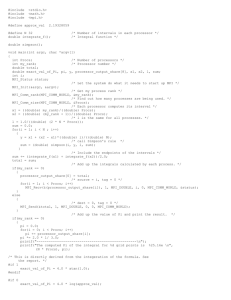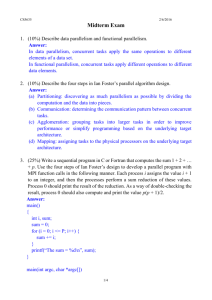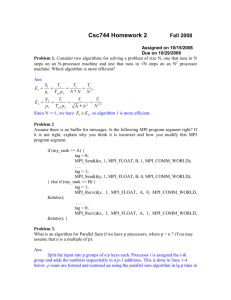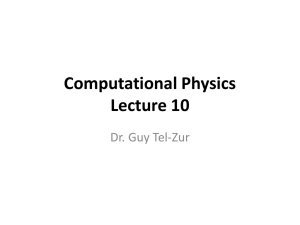Matrix Multiplication Introduction
advertisement
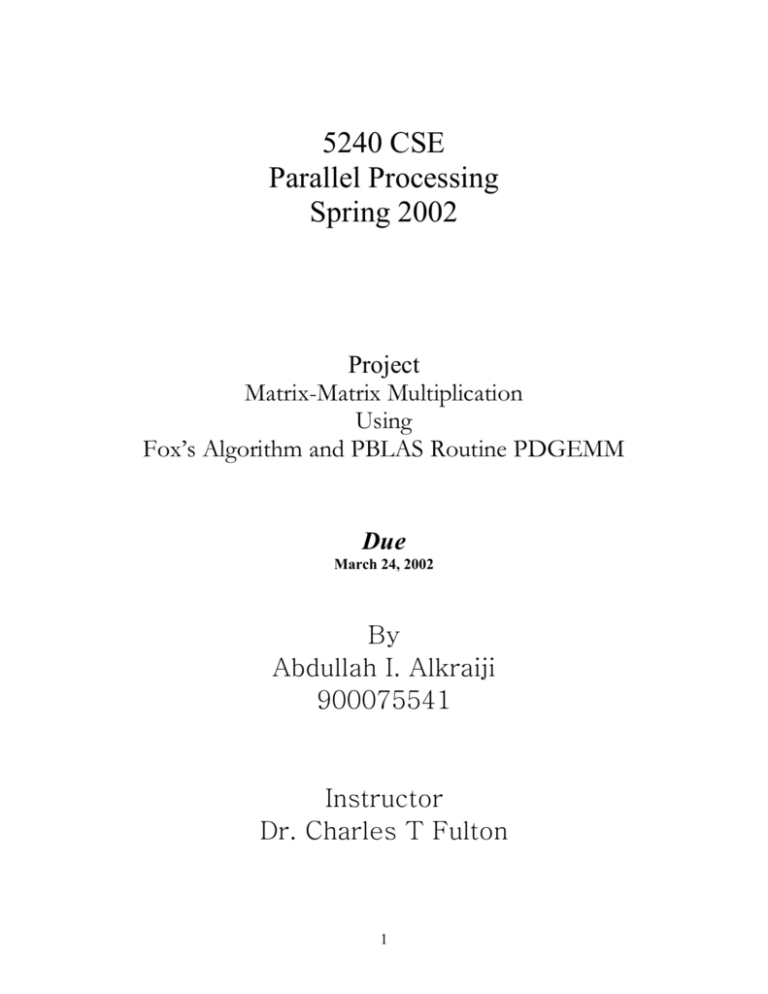
5240 CSE
Parallel Processing
Spring 2002
Project
Matrix-Matrix Multiplication
Using
Fox’s Algorithm and PBLAS Routine PDGEMM
Due
March 24, 2002
By
Abdullah I. Alkraiji
900075541
Instructor
Dr. Charles T Fulton
1
Continents
NO
1
2
3
4
5
7
8
9
10
11
Title
Matrix Multiplication Introduction
Parallel Algorithms for Square Matrices Multiplication
Checkerboard
Fox’s Algorithm
Fox’s Algorithm Psuedocode
Implementation of Fox’s Algorithm
1- MPI Data Type
2- MPI Function Calls
3- Program’s Function
Fox’s Algorithm Execution Results
ScaLAPACK Matrix-Matrix Multiplication PBLAS routine
(PDGEMM)
Comparing Fox’s Algorithm With PBLAS Routine
(PDGEMM)
Conclusion
Pages
3
3
4
4-6
6-8
8
8-9
9-12
12-16
16-18
18-21
21-22
22-23
References
NO Name
1
Parallel Programming with MPI
2
Parallel Programming
3
Introduction To Parallel Computing
4
Numerical Analysis
2
Author
Peter S. Pacheco
Barry Wilkinson
Michael Allen
Vipin Kumar
Ananth Grama
Anshul Gupta
George Karypis
Richard Burden
J. Douglas Faires
Matrix Multiplication Introduction
Definition-1: A square matrix has the same number of rows as columns.
Definition-2: If A = (aij) and B = (bij) are square matrix of order n, then C = (cij) = AB
is also a square matrix of order n, and cij is obtained by taking the dot product of the ith
row of A with the jth column of B. That is,
cij = ai0b0j + ai1b1j + … + ai,n-1bn-1,j.
Parallel Algorithms for Square Matrices Multiplication
There are several algorithms for square matrix multiplication, some of them are not
realistic; for the rest, each one has advantages and disadvantages. Following are examples
of both types:
1- First Algorithm is to assign each row of A to all of B to be sent to each process. For
simplicity, we assume that the number of processes is the same as the order of the
matrices p = n. Here’s algorithm for this method:
Send all of B to each process
Send ith row of A to ith process
Compute ith row of C on ith process
This algorithm would work assuming that there is a sufficient storage for each process to
store all of B. This algorithm will not be implemented for large n since it is not storage
efficient.
2- Second Algorithm, suppose that the number of processes is the same as the order of
the matrices p = n, and suppose that we have distributed the matrices by rows. So process
0 is assigned row 0 of A, B, and C; process 1 is assigned row 1 of A, B, and C; etc. Then
in order to form the dot product of the ith row of A with the jth column of B, we will need
to gather the jth column of B onto process i. But we will need to form the dot product of
the jth column with every row of A. Here’s algorithm for this method:
for each row of C
for each column of C
{
C [row] [column] = 0.0;
for each element of this row of A
Add A[row] [element] * B[element] [column] to C[row] [column]
}
Observe that a straightforward parallel implementation will be quite costly because this
will involve a lot of communication. Similar reasoning shows that an algorithm that
distributes the matrices by columns or that distributes each row of A and each column of
B to each process will also involve large amounts of communication.
3
Checkerboard
Based on the above considerations:
1- The excessive use of storage
2- The communication overhead
Most parallel matrix multiplication functions use a checkerboard distribution of the
matrices. This means that the processes are viewed as a grid, and, rather than assigning
entire rows or entire columns to each process, we assign small sub-matrices. For
example, if we have four processes, we might assign the element of a 4 4 matrix as
shown below, checkerboard mapping of a 4 4 matrix to four processes.
Process 0
a00 a01
a10 a11
Process 2
a20 a21
a30 a31
Process 1
a02 a03
a12 a13
Process 3
a22 a23
a32 a33
Fox’s Algorithm
Fox’s algorithm is a one that distributes the matrix using a checkerboard scheme like the
above. In order to simplify the discussion, let’s assume that the matrices have order n,
and the number of processes, p, equals n2. Then a checkerboard mapping assigns aij, bij,
and cij to process (i,j). In a process grid like the above, the process (i,j) is the same as
process p= i * n + j, or, loosely, process (i,j) using row major form in the process grid.
Fox’s algorithm for matrix multiplication proceeds in n stages: one stage for each term
aikbkj in the dot product
Cij = ai0b0j + ai1b1i + … + ai,n-1bn-1,j.
During the initial stage, each process multiplies the diagonal entry of A in its process row
by its element of B:
Stage 0 on process(i,j): cij=aiibij.
During the next stage, each process multiplies the element immediately to the right of the
diagonal of A by the element of B directly beneath its own element of B:
Stage 1 on process(i,j): cij = cij + ai,i+1bi+1,j.
4
In general, during the kth stage, each process multiplies the element k columns to the
right of the diagonal of A by the element k rows below its own element of B:
Stage k on process(i,j): cij = cij + ai,i+kbi+k,j.
Of, course, we can’t just add k to a row or column subscript and expect to always get a
valid row or column number. For example, if i = j = n –1, then any positive value added
to i or j will result in an out-of-range subscript. One possible solution is to use subscripts
module n. That is, rather than use i + k for a row or column subscript, use i + k mode n.
Perhaps we should say that the incomplete algorithm is correct. We still haven’t said how
we arrange that each process gets the appropriate values ai,k and bk,i. Thus, we need to
broadcast aik across the ith row before each multiplication. Finally, observe that during
the initial stage, each process uses its own element, bij, of B. During subsequent stages,
process(i,j) will use bik. Thus, after each multiplication is completed, the element of B
should be shifted up one row, and elements in the top row should be sent to the bottom
row.
Example-1: illustrates the stages in Fox’s algorithm for multiplying two 2 2 matrices
distributes across four processes.
Stages
Stage 0
Stage 1
First Step
a00
a01
a10
a11
a00
a01
a10
a11
Second Step
c00 = a00b00
c01 = a00b01
c10 = a11b10
c11 = a11b11
c00 = c00 + a01b10
c01 = c01 + a01b11
c10 = c10 + a10b00 c11 = c11 + a10b01
Third Step
b00
b01
b10
b11
b10
b11
b00
b01
First step: each blue element in the ith row of A will be multiplied by all of the
corresponding ith row of B in the third step.
Second step: assigns the result of the multiplications to cij.
Third Step: after each stage, the elements of B should be shifted up one row, and
elements in the top row should be sent to the bottom row.
5
Example-2: illustrates the stages in Fox’s algorithm for multiplying two 3 3 matrices
distributed across nine processes.
Stages
Stage 0
Stage 1
Stage 2
First Step
a00 a01 a02
a10 a11 a12
a20 a21 a22
a00 a01 a02
a10 a11 a12
a20 a21 a22
a00 a01 a02
a10 a11 a12
a20 a21 a22
c00+=a00b00
c10+=a11b10
c20+=a22b20
c00+=a01b10
c10+=a12b20
c20+=a20b00
c00+=a02b20
c10+=a10b00
c20+=a21b10
Second Step
c01+=a00b01
c11+=a11b11
c20+=a22b21
c01+=a01b11
c11+=a12b21
c21+=a20b01
c01+=a02b21
c11+=a10b01
c21+=a21b11
c02+=a00b02
c12+=a11b12
c22+=a22b22
c02+=a01b12
c12+=a12b22
c22+=a20b02
c02+=a02b22
c12+=a10b02
c22+=a21b12
Third Step
b00 b01 b02
b10 b11 b12
b20 b21 b22
b10 b11 b12
b20 b21 b22
b00 b01 b02
b20 b21 b22
b00 b01 b02
b10 b11 b12
Example-3: illustrates the stages in Fox’s algorithm for multiplying two 4 4 matrices
distributed across four processes.
For large n it is that we can unlikely access to n2 processors. So a natural solution would
seem to be to store sub-matrices rather than matrix elements on each process. We use a
square grid of processes, where the number of process rows or process columns, sqrt(p),
evenly divides n. With this assumption, each process is assigned a square
n/sqrt(p) n/sqrt(p)
sub-matrix of each of the three matrices. In our example p = 4, and n = 4, so the submatrices for matrix of A will be as following:
a00
a01
A00 =
a02
a03
A01 =
a10
a11
a12
a13
a20
a21
a22
a23
a32
a33
A10 =
A11 =
a30
a31
If we make similar definition of Bij and Cij, assign Aij, Bij, and Cij to process (i,j), and
we define q = sqrt(p), then our algorithm will compute
Cij = AiiBij + Ai,i+1Bi+1,j + … + Ai,q-1Bq-1,j + Ai0B0j + … +Ai,i-1Bi-1,j.
6
The stages for computing Cij will be as following:
Q
q=0
q=1
First Step
A00
A01
A10
A11
A00
A01
A10
A11
Second Step
C00 = A00B00
C01 = A00B01
C10 = A11B10
C11 = A11B11
C00 = C00 + A01B10 C01 = C01 + A01B11
C10 = C10 + A10B00
C11 = C11 + A10B01
Third Step
B00
B01
B10
B11
B10
B11
B00
B01
Fox’s Algorithm Psuedocode
/* my process row = i , my process column = j */
q = sqrt(p);
dest = ((i – 1) mod q , j);
source = ((i + 1) mod q, j);
for (stage = 0 ; stage < q ; stage++)
{
k_bar = (i + stage) mod q;
(a)
Broadcast A[i,k_bar] across process row i;
(b)
C[i,j] = C[i,j] + A[i,k_bar]*B[k_bar,j];
(c)
Send B[(k_bar+1) mod q, j] to dest;
Receive B[(k_bar+1) mod q, j] from source;
}
Process(0,0)
Process(0,1)
1- i = j = 0
2- Assign A00,B00,C00 to this
process(0,0)
3- q = 2
4- dest = (1,0)
5- source = (1,0)
6- stage = 0
7- k_bar = 0
8- Broadcast A00 across process row
i=0
9- C00 = C00 + A00 * B00
10- Send B00 to dest = (1,0)
11- Receive B10 from source = (1,0)
12- stage = 1
13- k_bar = 1
14- Broadcast A01 across process row
i=0
1- i = 0, j = 1
2- Assign A01,B01,C01 to this
process(0,1)
3- q = 2
4- dest= (1,1)
5- source= (0,1)
6- stage = 0
7- k_bar = 0
8- Broadcast A00 across process row
i=0
9- C01 = C01 + A00 * B01
10- Send B11 to dest = (1,1)
11- Receive B11 from source = (0,1)
12- stage = 1
13- k_bar = 1
14- Broadcast A01 across process row
i=0
7
15- C00 = C00 + A01B10
16- Send B00 to dest = (1,0)
17- Receive B00 from source = (1,0)
15- C01 = C01 + A01 * B11
16- Send B01 to dest = (1,1)
17- Receive B01 from source = (0,1)
Process(1,0)
Process(1,1)
1- i = 1, j = 0
2- Assign A10,B10,C10 to this
process(1,0)
3- q = 2
4- dest = (0,0)
5- source = (0,0)
6- stage = 0
7- k_bar = 1
8- Broadcast A11 across process row
i=1
9- C00 = C00 + A11 * B10
10- Send B00 to dest = (0,0)
11- Receive B00 from source = (0,0)
12- stage = 1
13- k_bar = 0
14- Broadcast A10 across process row
i=0
15- C00 = C00 + A10B00
16- Send B10 to dest = (0,0)
17- Receive B10 from source = (0,0)
1- i = 1, j = 1
2- Assign A11,B11,C11 to this
process(1,1)
3- q = 2
4- dest = (0,1)
5- source = (0,1)
6- stage = 0
7- k_bar = 1
8- Broadcast A11 across process row
i=1
9- C11 = C11 + A11 * B11
10- Send B01 to dest = (0,1)
11- Receive B01 from source = (0,1)
12- stage = 1
13- k_bar = 0
14- Broadcast A10 across process row
i=1
15- C11 = C11 + A10B01
16- Send B11 to dest = (0,1)
17- Receive B11 from source = (0,1)
Implementation of Fox’s Algorithm
In this section, we will describe the MPI Datatype, MPI Function Calls, and Functions
that are used in our Fox’s program.
MPI Data Type
1- MPI_Comm: It a communicator that contains all of the processes.
2- MPI_Datatype: The principle behind MPI’s derived datatypes is to provide all of
the information except the address of the beginning of the message in a new MPI
datatype. Then, when a program calls MPI_Send, MPI_Recv, etc., it simply
provides the address of the first element, and the communication subsystem can
determine exactly what needs to be sent or received.
8
3- MPI_Status: It is a structure that consists of five elements, and the descriptions for
the three elements are:
astatus.source =
process source of received data
status.tag
=
tag(integer) of received data
status.error
=
error status of reception
4- MPI_Aint: It declares the variable to be an integer type that holds any valid
address.
MPI Function Calls:
1- MPI_Init: Before any other MPI functions can be called, the function MPI_Init
must be called, and it should only be called once. Here’s he syntax for this
function
MPI_Init(&argc, &argv); .
2- MPI_Comm_rank: It returns the rank of a process in its second parameter. The
first parameter is a communicator. Essentially a communicator is a collection of
processes that can send messages to each other. Its syntax as following:
int MPI_Comm_rank(MPI_Comm comm, int* my_rank)
3- MPI_Bcast: It is a collective communication in which a single process sends the
same data to every process in the communicator.It simply sends a copy of the data
in message on the process with rank root to each process in the communicator
comm.. It should be called by all the processes in the communicator with the same
argument for root and comm. The syntax of MPI_Bcast is
int MPI_Bcast(
void*
message,
int
count,
MPI_Datatype datatype,
int
root,
MPI_Comm comm.)
4- MPI_Comm_size: It gives the number of processes that are involved in the
execution of a program, it can call
int MPI_Comm_size(MPI_Comm comm, int* number_of_processes)
5- MPI_Cart_create: It creates a new communicator, cart_comm., by caching a
Cartesian topology with old_comm. Information on the structure of the Cartesian
topology is contained in the parameters number_of_dims, dim_sizes, and
warp_around. The first of these, number_of_dims, contains the number of
dimensions in the Cartesian coordinates system. The next two, dim_size and
wrap_around, are arrays with the order equal to number_of_dims. The array
dim_size specifies the order of each dimension, and wrap_around specifies
whether each dimension is circular, wrap_around[i]= 1, or linear,
wrap_around[i]= 0. The processes in cart_comm are linked in row-major order.
That is, the first row cosists of processes 0,1,…,dim_size[0]-1; the second row
consists of processes dim_size[0], dim_size[0]+1, …, 2*dim_size[0]-1; etc. The
syntax of MPI_Cart_create is
int MPI_Cart_create(
MPI_Comm
old_comm,
9
6-
7-
8-
9-
int
number_of_dim,
int
dim_size[],
int
wrap_around[],
int
reorder,
MPI_Comm*
cart_comm)
MPI_Cart_coords: It returns the coordinates of the process with rank in the
Cartesian communicator comm. The syntax as following
int MPI_Cart_coords(
MPI_Comm
comm,
int
rank,
int
number_of_dims,
int
coordinates[])
MPI_Cart_rank: It returns the rank in the Cartesian communicator comm of the
process with Cartesian coordinates. So coordinates is an array with order equal to
the number of dimensions in the Cartesian topology associated with comm. The
syntax is
int MPI_Cart_rank(
MPI_Comm
comm,
int
coordinates[],
int*
rank)
MPI_Cart_sub: The call to MPI_Cart_sub creates q new communicators. The
free_cords parameter is an array of Boolean. It specifies whether each dimension
belong to the new communicator consists of the processes obtained by fixing the
row coordinate and letting the column coordinate vary; i.e., the row coordinate is
fixed and the column coordinate is free. MPI_Cart_sub can only be used with a
communicator that has an associated Cartesian topology, and the new
communicators can only be created by fixing one or more dimensions of the old
communicators and letting the other dimensions vary. The syntax is
int MPI_Cart_sub(
MPI_Comm
cart_comm,
int
free_coords[],
MPI_Comm*
new_comm)
MPI_Sendrecv_replace: It performs both the send and the receive required for the
circular shift of local_B: it sends the current copy of local_B to the process in
col_comm with rank dest, and then receives the copy of local_B residing on the
process in col_comm with rank source. It sends the contents of buffer to the
process in comm with rank dest and receives in buffer data sent from the process
with rank source. The send uses the tag send_tag, and the receive uses the tag
recv_tag. The processes involved in the send and receive do not have to be
distinct. Its syntax is
int MPI_Sendrecv_replace(
void*
buffer,
int
count,
MPI_Datatype
datatype,
int
dest,
int
send_tag,
10
int
source,
int
recv_tag,
MPI_Comm
comm,
MPI_Status*
status)
10- MPI_Send: The contents of the message are stored in a block of memory
referenced by the parameter message. The next two parameters, count, and
datatype, allow the system to determine how much storage is needed for the
message: the message contains a sequence of count values, each having MPI type
datatype. The parameter source is the rank of the receiving process. The tag is an
int. The exact syntax is
int MPI_Send(
void*
message,
int
count,
MPI_Datatype datatype,
Int
dest,
Int
tag,
MPI_Comm comm.)
11- MPI_Recv: The syntax for this function is:
int MPI_Recv(
void*
message,
int
count,
MPI_Datatype datatype,
int
source,
int
tag,
MPI_Comm comm.,
MPI_status* status)
The first six parameters are the same that we described with MPI_Send, but the
last one status, returns information on the data that was actually received.
12- MPI_Type_contiguous: It is constructor that builds a derived type whose elements
are contiguous entries in an array. In MPI_Type_contiguous, one simply specifies
that the derived type new_mpi_t will consist of count contiguous elements, each
of which has type old_type. The syntax is
int MPI_Type_contiguous(
int
count,
MPI_Datatype old_type,
MPI_Datatype* new_mpi_t)
13- MPI_Address: In order to compute addresses, we use MPI_Address function. It
returns the byte address of location in address, and the syntax as following
MPI_Address(
void*
location,
MPI_Aint
address)
14- MPI_Type_struct: This function has five parameters. The first parameter count is
the number of blocks of elements in the derived type. It is also the size of the
three arrays, block_lengths, displacements, and typelist. The array block_lengths
contains the number of entries in each element of the type. So if an element of the
type is an array of m values, then the corresponding entry in block_length is m.
11
The array displacements contains the displacement of each element from the
beginning of the message, and the typelist contains the MPI datatype of each
entry. The parameter new_mpi_t returns a pointer to the MPI datatype created by
the call to MPI_Type_struct. Its syntax is
int MPI_Type_struct(
int
count,
int
block_lengths[],
MPI_Aint
displacements[],
MPI_Datatype typelist[],
MPI_Datatype* new_mpi_t)
15- MPI_Type_commit: After the call to MPI_Type_struct, we cannot use new_mpi_t
in communication functions until we call MPI_Type_commit. This is a
mechanism for the system to make internal changes in the representaion of
new_mpi_t that may improve the communication performance. Its syntax is
simply
int MPI_Type_commit(
MPI_Datatype*
new_mpi_t)
Program’s Function:
1- Setup_grid: This function creates the various communicators and associated
information. Notice that since each of our communicators has associated
topology, we constructed them using the topology construction functions
MPI_Cart_creat and MPI_Cart_sub rather than the more general communicator
construction functions MPI_Comm_create and MPI_Comm_split. The outline for
this code is
void Setup_grid(
GRID_INFO_T* grid
int old_rank;
int dimensions[2];
int wrap_around[2];
int coordinates[2];
/* out */) {
int free_coords[2];
/* Set up Global Grid Information */
MPI_Comm_size(MPI_COMM_WORLD, &(grid->p));
MPI_Comm_rank(MPI_COMM_WORLD, &old_rank);
/* We assume p is a perfect square */
grid->q = (int) sqrt((double) grid->p);
dimensions[0] = dimensions[1] = grid->q;
/* We want a circular shift in second dimension. */
/* Don't care about first
*/
wrap_around[0] = wrap_around[1] = 1;
MPI_Cart_create(MPI_COMM_WORLD, 2, dimensions,
wrap_around, 1, &(grid->comm));
MPI_Comm_rank(grid->comm, &(grid->my_rank));
MPI_Cart_coords(grid->comm, grid->my_rank, 2,
coordinates);
12
grid->my_row = coordinates[0];
grid->my_col = coordinates[1];
/* Set up row communicators */
free_coords[0] = 0;
free_coords[1] = 1;
MPI_Cart_sub(grid->comm, free_coords,
&(grid->row_comm));
/* Set up column communicators */
free_coords[0] = 1;
free_coords[1] = 0;
MPI_Cart_sub(grid->comm, free_coords,
&(grid->col_comm));
} /* Setup_gr
2- Fox: This function does the actual multiplication for each process. It uses
MPI_Bcast for distributing sub-matrices (A) among other processes in the same
row and MPI_Sendrecv_replace for distributing sub-matrices (B) among
processes in the same column. Its code is
void Fox(
int
GRID_INFO_T*
LOCAL_MATRIX_T*
n
grid
local_A
/* in
/* in
/* in
LOCAL_MATRIX_T*
LOCAL_MATRIX_T*
local_B
local_C
/* in */,
/* out */) {
LOCAL_MATRIX_T*
*/,
*/,
*/,
int
int
int
int
temp_A; /* Storage for the sub/* matrix of A used during
/* the current stage
stage;
bcast_root;
n_bar; /* n/sqrt(p)
source;
int
MPI_Status
dest;
status;
*/
*/
*/
*/
n_bar = n/grid->q;
Set_to_zero(local_C);
/* Calculate addresses for circular shift of B */
source = (grid->my_row + 1) % grid->q;
dest = (grid->my_row + grid->q - 1) % grid->q;
/* Set aside storage for the broadcast block of A */
temp_A = Local_matrix_allocate(n_bar);
for (stage = 0; stage < grid->q; stage++) {
bcast_root = (grid->my_row + stage) % grid->q;
if (bcast_root == grid->my_col) {
MPI_Bcast(local_A, 1, local_matrix_mpi_t,
bcast_root, grid->row_comm);
13
Local_matrix_multiply(local_A, local_B,
local_C);
} else {
MPI_Bcast(temp_A, 1, local_matrix_mpi_t,
bcast_root, grid->row_comm);
Local_matrix_multiply(temp_A, local_B,
local_C);
}
MPI_Sendrecv_replace(local_B, 1,
local_matrix_mpi_t,
dest, 0, source, 0, grid->col_comm, &status);
} /* for */
} /* Fox */
3- Read_matrix: This function reads and distributes matrix among the processes.
Process 0 reads a block of n_bar and sends it to the appropriate process. The
outline code is
void Read_matrix(
char*
LOCAL_MATRIX_T*
GRID_INFO_T*
int
int
int
int
int
float*
MPI_Status
prompt
local_A
grid
n
/*
/*
/*
/*
in
out
in
in
*/,
*/,
*/,
*/) {
mat_row, mat_col;
grid_row, grid_col;
dest;
coords[2];
temp;
status;
if (grid->my_rank == 0) {
temp = (float*)
malloc(Order(local_A)*sizeof(float));
printf("%s\n", prompt);
fflush(stdout);
for (mat_row = 0; mat_row < n; mat_row++) {
grid_row = mat_row/Order(local_A);
coords[0] = grid_row;
for (grid_col = 0; grid_col < grid->q;
grid_col++) {
coords[1] = grid_col;
MPI_Cart_rank(grid->comm, coords, &dest);
if (dest == 0) {
for (mat_col = 0; mat_col <
Order(local_A); mat_col++)
scanf("%f",
(local_A>entries)+mat_row*Order(local_A)+mat_col);
} else {
for(mat_col = 0; mat_col <
Order(local_A); mat_col++)
scanf("%f", temp + mat_col);
MPI_Send(temp, Order(local_A),
MPI_FLOAT, dest, 0,
14
grid->comm);
}
}
}
free(temp);
} else {
for (mat_row = 0; mat_row < Order(local_A);
mat_row++)
MPI_Recv(&Entry(local_A, mat_row, 0),
Order(local_A),
MPI_FLOAT, 0, 0, grid->comm, &status);
}
}
/* Read_matrix */
4- Local_matrix_multiply: This function gets the appropriate A, B and C submatrices from the fox function and does the multiplication. Its code is
void Local_matrix_multiply(
LOCAL_MATRIX_T* local_A
LOCAL_MATRIX_T* local_B
LOCAL_MATRIX_T* local_C
int i, j, k;
/* in */,
/* in */,
/* out */) {
for (i = 0; i < Order(local_A); i++)
for (j = 0; j < Order(local_A); j++)
for (k = 0; k < Order(local_B); k++)
Entry(local_C,i,j) = Entry(local_C,i,j)
+
Entry(local_A,i,k)*Entry(local_B,k,j);
}
/* Local_matrix_multiply */
5- Build_matrix_type: This function builds the matrices contiguously in the storage,
get the address for each one, and the number of blocks that each one has. The
outline is
void Build_matrix_type(
LOCAL_MATRIX_T* local_A /* in */) {
MPI_Datatype temp_mpi_t;
int
block_lengths[2];
MPI_Aint
displacements[2];
MPI_Datatype typelist[2];
MPI_Aint
start_address;
MPI_Aint
address;
MPI_Type_contiguous(Order(local_A)*Order(local_A),
MPI_FLOAT, &temp_mpi_t);
block_lengths[0] = block_lengths[1] = 1;
typelist[0] = MPI_INT;
typelist[1] = temp_mpi_t;
MPI_Address(local_A, &start_address);
MPI_Address(&(local_A->n_bar), &address);
15
displacements[0] = address - start_address;
MPI_Address(local_A->entries, &address);
displacements[1] = address - start_address;
}
MPI_Type_struct(2, block_lengths, displacements,
typelist, &local_matrix_mpi_t);
MPI_Type_commit(&local_matrix_mpi_t);
/* Build_matrix_type */
Fox’s Algorithm Execution Results
The tables below show the result of executing fox algorithm (cpu_time, mflop) with
P = 4, 9, 16, 25 36
and N = 720
M-flop over all Processes = ( 2 * n ^ 3 ) / ( 10 ^ 6 * Max (cpu time overall processes))
My Rank
0
1
2
3
0
1
2
3
4
5
6
7
8
0
1
2
3
4
5
6
7
8
9
10
11
12
P = 4 and N =720
cpu time
3.500000e+00 seconds
4.170000e+00 seconds
4.180000e+00 seconds
4.190000e+00 seconds
P = 9 and N =720
1.480000e+00 seconds
1.410000e+00 seconds
1.620000e+00 seconds
1.390000e+00 seconds
1.490000e+00 seconds
1.420000e+00 seconds
1.440000e+00 seconds
1.420000e+00 seconds
1.730000e+00 seconds
P = 16 and N =720
8.200000e-01 seconds
9.800000e-01 seconds
1.020000e+00 seconds
8.400000e-01 seconds
1.000000e+00 seconds
9.200000e-01 seconds
8.200000e-01 seconds
8.200000e-01 seconds
8.500000e-01 seconds
8.300000e-01 seconds
8.200000e-01 seconds
8.500000e-01 seconds
8.100000e-01 seconds
M-flop for each P
0.296229
0.248633
0.248038
0.247446
0.700541
0.735319
0.640000
0.745899
0.695839
0.730141
0.720000
0.730141
0.599306
1.264390
1.057959
1.016471
1.234286
1.036800
1.126957
1.264390
1.264390
1.016471
1.249157
1.264390
1.219765
1.280000
16
M-flop overall Ps
178.161336
431.500578
746.496
13
14
15
0
1
2
3
4
5
6
7
8
9
10
11
12
13
14
15
16
17
18
19
20
21
22
23
24
0
1
2
3
4
5
6
7
8
9
10
11
12
13
14
8.600000e-01 seconds
8.600000e-01 seconds
8.400000e-01 seconds
P = 25 and N =720
5.600000e-01 seconds
6.400000e-01 seconds
5.900000e-01 seconds
6.300000e-01 seconds
6.400000e-01 seconds
6.900000e-01 seconds
6.700000e-01 seconds
6.600000e-01 seconds
6.700000e-01 seconds
6.300000e-01 seconds
6.200000e-01 seconds
6.000000e-01 seconds
5.400000e-01 seconds
5.800000e-01 seconds
5.900000e-01 seconds
5.600000e-01 seconds
6.200000e-01 seconds
5.700000e-01 seconds
5.700000e-01 seconds
5.700000e-01 seconds
5.700000e-01 seconds
6.000000e-01 seconds
5.900000e-01 seconds
5.600000e-01 seconds
6.000000e-01 seconds
P = 36 and N =720
4.200000e-01 seconds
4.400000e-01 seconds
4.200000e-01 seconds
4.400000e-01 seconds
4.300000e-01 seconds
4.700000e-01 seconds
4.100000e-01 seconds
4.100000e-01 seconds
4.200000e-01 seconds
4.400000e-01 seconds
4.300000e-01 seconds
4.500000e-01 seconds
4.000000e-01 seconds
4.000000e-01 seconds
4.000000e-01 seconds
1.205581
1.205581
1.234286
1.851429
1.620000
1.757288
1.645714
1.620000
1.502609
1.547463
1.570909
1.547463
1.645714
1.672258
1.728000
1.920000
1.787586
1.757288
1.851429
1.672258
1.818947
1.818947
1.818947
1.818947
1.728000
1.757288
1.851429
1.728000
2.468571
2.356364
2.468571
2.356364
2.411163
2.205957
2.528780
2.528780
2.468571
2.356364
2.411163
2.304000
2.592000
2.592000
2.592000
17
1081.87826
1588.289361
15
16
17
18
19
20
21
22
23
24
25
26
27
28
29
30
31
32
33
34
35
4.000000e-01 seconds
4.200000e-01 seconds
3.900000e-01 seconds
4.000000e-01 seconds
4.000000e-01 seconds
4.100000e-01 seconds
3.800000e-01 seconds
3.900000e-01 seconds
4.000000e-01 seconds
4.100000e-01 seconds
4.000000e-01 seconds
4.100000e-01 seconds
3.600000e-01 seconds
4.000000e-01 seconds
4.000000e-01 seconds
4.200000e-01 seconds
4.000000e-01 seconds
4.100000e-01 seconds
3.900000e-01 seconds
4.100000e-01 seconds
4.000000e-01 seconds
2.592000
2.468571
2.658462
2.592000
2.592000
2.528780
2.728421
2.658462
2.592000
2.528780
2.592000
2.528780
2.880000
2.592000
2.592000
2.468571
2.592000
2.528780
2.658462
2.528780
2.592000
ScaLAPACK Matrix-Matrix Multiplication PBLAS routine (PDGEMM)
ScaLAPACK is a library of high-performance linear algebra routines for distributedmemory message-passing computers and networks of workstations supporting PVM and
MPI. The library is currently written in Fortran 77 in a Single Program Multiple Data
(SPMD) style using explicit message passing for interprocessor communication. The
ScaLAPACK routines are based on block-partitioned algorithms in order to minimize the
frequency of data movement between different levels of the memory hierarchy. The
fundamental building blocks of the ScaLAPACK library are distributed-memory versions
of the Level 1, Level 2, and Level 3 BLAS, called the Parallel BLAS or PBLAS, and a
set of Basic Linear Algebra Communication subprograms (BLACS) for communication
tasks that arise frequently in parallel linear algebra computations. In the ScaLAPACK
routines, the majority of interprocessor communication occurs within the PBLAS.
ScaLAPACK contains driver routines for solving standard types of problems,
computational routines to perform a distinct computational task, and auxiliary routines to
perform a certain subtask or common low-level computation. Each driver routine
typically calls a sequence of computation routines. Four basics steps are required to call a
ScaLAPACK routine:
IInitialize the process grid
IIDistribute the matrix on the process grid
IIICall ScaLAPACK routine
IVRelease the process grid
18
Every ScaLAPACK routine call is referenced to PBLAS.dat that has some parameters,
which are needed, in order to accomplish the function. The parameters for this file are
described below
M
N
K
NB
P
Q
: The number of rows in the matrices A and C.
: The number of columns in the matrices B and C.
: The number of rows of B and the number of columns of A.
:The size of the square blocks the matrices A, B and C are split into.
:The number of process rows.
:he number of process columns.
In our case (Square Matrix-Matrix Multiplication), M, N, and K are the same values.The
tables below show the result of executing PBLAS routine (cpu_time, mflop) with
P = 4, 9, 16, 25 36
and N = 720
M-flop over all Processes = ( 2 * n ^ 3 ) / ( 10 ^ 6 * Max (cpu time overall processes))
My Rank
0
1
2
3
0
1
2
3
4
5
6
7
8
0
1
2
3
4
5
6
7
8
9
10
11
P = 4, N =720, and NB = 360
cpu time
0.3800000
0.3600000
0.3500000
0.3800000
P = 9, N =720, and NB = 240
0.1800000
0.2100000
0.1700000
0.2000000
0.1800000
0.1900000
0.2000000
0.2000000
0.2200000
P = 16, N =720, and NB = 180
0.1000000
0.1400000
0.1300000
0.1600000
0.1300000
0.1200000
9.9999994E-02
0.1300000
0.1800000
0.1500000
0.1300000
0.1100000
19
M-flop for each P
2.728421
2.880000
2.962286
2.728421
5.760000
4.937143
6.098824
5.184000
5.760000
5.456842
5.184000
5.184000
4.712727
10.36800
7.405715
7.975385
6.480000
7.975385
8.639999
10.36800
7.975384
5.760000
6.912000
7.975384
9.425454
M-flop overall P’s
1964.463157
3393.6363
4147.2
12
13
14
15
0
1
2
3
4
5
6
7
8
9
10
11
12
13
14
15
16
17
18
19
20
21
22
23
24
0
1
2
3
4
5
6
7
8
9
10
11
12
13
0.1200000
0.1300000
0.1400000
0.1200000
P = 5, N =720, and NB = 144
9.0000004E-02
6.9999993E-02
9.0000004E-02
6.9999993E-02
0.1000000
9.0000004E-02
9.0000004E-02
5.0000012E-02
0.1000000
9.9999994E-02
0.1300000
6.9999993E-02
9.0000004E-02
8.9999974E-02
6.9999993E-02
6.9999993E-02
9.9999994E-02
0.1100000
7.0000008E-02
8.9999989E-02
7.9999998E-02
0.1100000
0.1200000
8.9999996E-02
9.9999994E-02
P = 36, N =720, and NB = 120
7.0000000E-02
0.2700000
6.9999993E-02
0.1000000
9.0000033E-02
8.9999974E-02
6.0000002E-02
8.9999974E-02
6.0000002E-02
7.0000023E-02
5.9999943E-02
6.9999993E-02
6.9999993E-02
6.0000032E-02
20
8.639999
7.975385
7.405715
8.640000
11.52000
14.81143
11.52000
14.81143
10.36800
11.52000
11.52000
20.73599
10.36800
10.36800
7.975385
14.81143
11.52000
11.52000
14.81143
14.81143
10.36800
9.425454
14.81143
11.52000
12.96000
9.425454
8.640000
11.52000
10.36800
14.81143
3.839999
14.81143
10.36800
11.52000
11.52000
17.28000
11.52000
17.28000
14.81142
17.28002
14.81143
14.81143
17.27999
5742.27692
7464.96
14
15
16
17
18
19
20
21
22
23
24
25
26
27
28
29
30
31
32
33
34
35
9.9999964E-02
0.1000000
6.0000002E-02
5.0000012E-02
9.0000004E-02
7.9999983E-02
5.0000012E-02
4.9999982E-02
6.9999993E-02
8.0000013E-02
0.1000000
6.0000002E-02
7.0000008E-02
6.9999993E-02
6.9999993E-02
7.9999998E-02
3.0000001E-02
4.9999997E-02
5.9999987E-02
7.9999998E-02
6.9999993E-02
6.9999993E-02
10.36800
10.36800
17.28000
20.73599
11.52000
12.96000
20.73599
20.73601
14.81143
12.96000
10.36800
17.28000
14.81143
14.81143
14.81143
12.96000
34.56000
20.73600
17.28000
12.96000
14.81143
14.81143
Comparing Fox’s Algorithm With PBLAS Routine (PDGEMM)
The table below shows the speedup table for both Fox’s Algorithm and PBLAS
Routine, where n = 720
Fox
Time on
Process 0
4 3.500000e+00
9 1.480000e+00
16 8.200000e-01
25 5.600000e-01
36 4.200000e-01
P
Speed
up
2.3648
4.2683
6.25
8.33
PBLAS
Time on
Process 0
4
0.3800000
9
0.1800000
16
0.1000000
25 9.0000004E-02
36 7.0000000e-02
M-flop on
Process 0
0.296229
0.700541
1.264390
1.851429
2.468571
P
21
Speed up
2.11
3.80
4.22
5.42857
M-flop on
Process 0
2.728421
5.760000
10.36800
11.52000
14.81143
The speedup table using the M-flop rate overall processes:
M-flop over all Processes = ( 2 * n ^ 3 ) / ( 10 ^ 6 * Max (cpu time overall processes))
P
4
9
16
25
36
Fox
Largest cpu
time
4.180000
1.730000
1.020000
0.690000
0.470000
Speed
up
2.416
4.098
6.057
8.893
M-flop
overall Ps
178.16133
431.50057
746.496
1081.8782
1588.2893
P
4
9
16
25
36
PBLAS
Largest cpu
time
0.380000
0.220000
0.180000
0.130000
0.100000
Speed up
1.727
2.111
2.923
3.800
M-flop
overall Ps
1964.4631
3393.6363
4147.2
5742.2769
7464.96
From the above tables we can result that PBLAS Routine (PDGEMM) performance is
more efficient than Fox’s Algorithm.
Conclusion
III-
III-
The number of processes using Fox’s Algorithm must be a perfect
square.
The number of processes using Fox’s Algorithm depends on the order
of n; i.e., P = K processes, then N must be chosen, so the N/sqrt(P) is
integer.
We can rewrite the Fox’s Algorithm to use Bcast data between
columns instead of using send and receive as following
/* my process row = i , my process column = j */
q = sqrt(p);
dest = ((i – 1) mod q , j);
source = ((i + 1) mod q, j);
for (stage = 0 ; stage < q ; stage++)
{
k_bar = (i + stage) mod q;
1. Broadcast A[i,k_bar] across process row i;
2. Broadcast B[k_bar,j] across process column j;
3. C[i,j] = C[i,j] + A[i,k_bar]*B[k_bar,j];
}
Let’s take example-3 to run it on this algorithm to show how it works.
22
Process(0,0)
Process(0,1)
i=j=0
Assign A00,B00,C00 to this process(0,0)
q=2
dest = (1,0)
source = (1,0)
stage = 0
k_bar = 0
Broadcast A00 across process row i = 0
Broadcast B00 across process column j =0
C00 = C00 + A00 * B00
stage = 1
k_bar = 1
Broadcast A01 across process row i = 0
Broadcast B10 across process column j = 0
C00 = C00 + A01 * B10
i = 0, j = 1
assign A01,B01,C01 to this process(0,1)
q=2
dest= (1,1)
source= (0,1)
stage = 0
k_bar = 0
Broadcast A00 across process row i = 0
Broadcast B01 across process column j =1
C01 = C01 + A00 * B01
stage = 1
k_bar = 1
Broadcast A01 across process row i=0
Broadcast B11 across process column j = 1
C01 = C01 + A01 * B11
Process(1,0)
Process(1,1)
i = 1, j = 0
Assign A10,B10,C10 to this process(1,0)
q=2
dest = (0,0)
source = (0,0)
stage = 0
k_bar = 1
Broadcast A11 across process row i = 1
Broadcast B10 across process column i =1
C10 = C10 + A11 * B10
stage = 1
k_bar = 0
Broadcast A10 across process row i = 1
Broadcast B00 across process column i = 1
C10 = C10 + A10 * B00
i = 1, j = 1
Assign A11,B11,C11 to this process(1,1)
q=2
dest = (0,1)
source = (0,1)
stage = 0
k_bar = 1
Broadcast A11 across process row i = 1
Broadcast B11 across process column i =1
C11 = C11 + A11 * B11
stage = 1
k_bar = 0
Broadcast A10 across process row i = 1
Broadcast B01 across process column i = 1
C11 = C11 + A10 * B01
IV. Applying ScaLAPACK PBLAS Routine (PDGEMM) for Matrix-Matrix
Multiplication is much faster than using Fox’s Algorithm.
23



